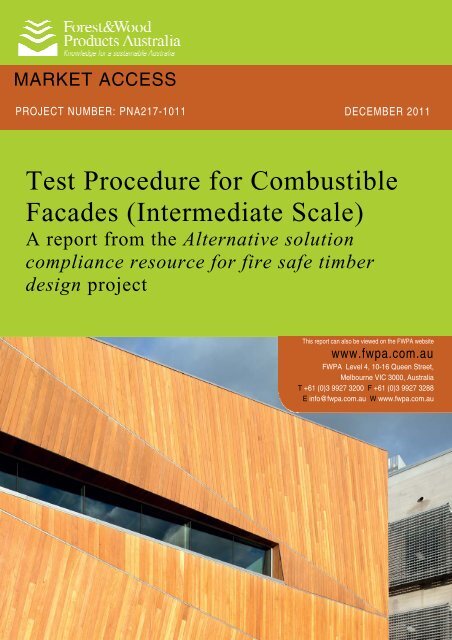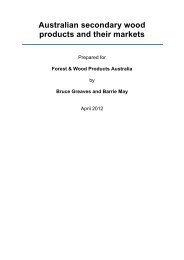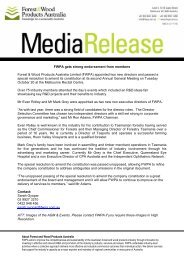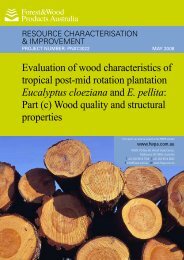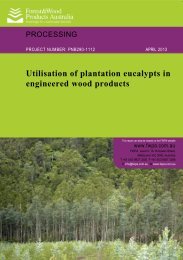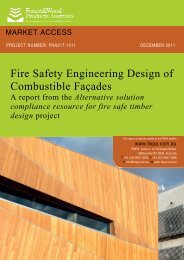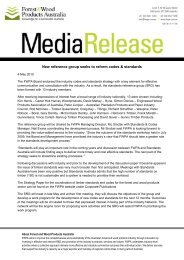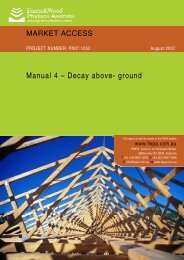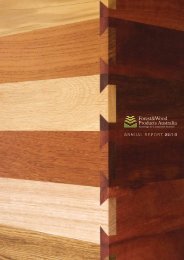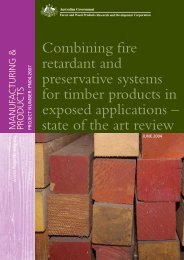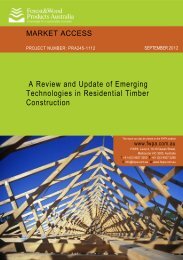Test Procedure for Combustible Facades (Intermediate Scale)-Issue ...
Test Procedure for Combustible Facades (Intermediate Scale)-Issue ...
Test Procedure for Combustible Facades (Intermediate Scale)-Issue ...
You also want an ePaper? Increase the reach of your titles
YUMPU automatically turns print PDFs into web optimized ePapers that Google loves.
MARKET ACCESS<br />
PROJECT NUMBER: PNA217-1011<br />
<strong>Test</strong> <strong>Procedure</strong> <strong>for</strong> <strong>Combustible</strong><br />
<strong>Facades</strong> (<strong>Intermediate</strong> <strong>Scale</strong>)<br />
A report from the Alternative solution<br />
compliance resource <strong>for</strong> fire safe timber<br />
design project<br />
DECEMBER 2011<br />
This report can also be viewed on the FWPA website<br />
www.fwpa.com.au<br />
FWPA Level 4, 10-16 Queen Street,<br />
Melbourne VIC 3000, Australia<br />
T +61 (0)3 9927 3200 F +61 (0)3 9927 3288<br />
E info@fwpa.com.au W www.fwpa.com.au
<strong>Test</strong> <strong>Procedure</strong> <strong>for</strong> <strong>Combustible</strong> <strong>Facades</strong><br />
(<strong>Intermediate</strong> <strong>Scale</strong>)<br />
Prepared <strong>for</strong><br />
Forest & Wood Products Australia<br />
by<br />
Exova Warringtonfire Aus Pty Ltd
Publication: <strong>Test</strong> <strong>Procedure</strong> <strong>for</strong> <strong>Combustible</strong> <strong>Facades</strong> (<strong>Intermediate</strong><br />
<strong>Scale</strong>)<br />
Project No: PNA217-1011<br />
© 2011 Forest & Wood Products Australia Limited. All rights reserved.<br />
Forest & Wood Products Australia Limited (FWPA) makes no warranties or assurances with respect to<br />
this publication including merchantability, fitness <strong>for</strong> purpose or otherwise. FWPA and all persons<br />
associated with it exclude all liability (including liability <strong>for</strong> negligence) in relation to any opinion, advice<br />
or in<strong>for</strong>mation contained in this publication or <strong>for</strong> any consequences arising from the use of such<br />
opinion, advice or in<strong>for</strong>mation.<br />
This work is copyright and protected under the Copyright Act 1968 (Cth). All material except the<br />
FWPA logo may be reproduced in whole or in part, provided that it is not sold or used <strong>for</strong> commercial<br />
benefit and its source (Forest & Wood Products Australia Limited) is acknowledged. Reproduction or<br />
copying <strong>for</strong> other purposes, which is strictly reserved only <strong>for</strong> the owner or licensee of copyright under<br />
the Copyright Act, is prohibited without the prior written consent of Forest & Wood Products Australia<br />
Limited.<br />
ISBN: 978-1-921763-33-5<br />
Researchers:<br />
Paul England, Matthew Eyre<br />
Exova Warringtonfire Aus Pty Ltd<br />
Unit 2<br />
409-411 Hammond Road<br />
Dandenong<br />
Victoria, 3175<br />
Australia<br />
Report <strong>Issue</strong> Number: 1<br />
Report <strong>Issue</strong> Date: 24/5/2011<br />
This is not the final report.<br />
Forest & Wood Products Australia Limited<br />
Level 4, 10-16 Queen St, Melbourne, Victoria, 3000<br />
T +61 3 9927 3200 F +61 3 9927 3288<br />
E info@fwpa.com.au<br />
W www.fwpa.com.au
Table of Contents<br />
1 Introduction ...................................................................................................................... 11<br />
2 Modifications to ISO 13785-1 ............................................................................................ 2<br />
2.1 General ......................................................................................................................... 2<br />
2.2 Fire source ................................................................................................................... 2<br />
2.3 Instrumentation ............................................................................................................ 2<br />
2.4 Imposed radiant heat flux ............................................................................................ 2<br />
2.5 Specimen holder .......................................................................................................... 2<br />
2.6 <strong>Test</strong> procedure ............................................................................................................. 2<br />
2.7 <strong>Test</strong> reporting ............................................................................................................. 33<br />
3 Validity ............................................................................................................................. 44<br />
4 References ........................................................................................................................ 55
1 Introduction<br />
This document specifies modifications to the ISO 13785-1 (ISO, 2002) standard to address two<br />
issues, namely:<br />
To introduce a more realistic, practical and cost effective fuel source by using timber<br />
cribs.<br />
To address the issue of fire spread from adjacent buildings by imposing a radiant<br />
heat flux.<br />
ISO 13785-1 was developed to provide a screening method <strong>for</strong> determining the reaction to fire<br />
per<strong>for</strong>mance of products and constructions of facades or claddings when exposed to heat from a<br />
simulated fire venting through a window. The test covers a simple representation of one fire<br />
scenario. The screening method is intended to be used in conjunction with full scale test (such as<br />
ISO 13785-2 (ISO, 2002)).<br />
The modifications in this document substitute wood cribs in lieu of a gas burner as the fire source.<br />
This is considered to give a more realistic, practical and cost effective test method.<br />
Radiant heat flux is imposed using a radiant panel. This can help generate data relating to fire<br />
spread from adjacent burning buildings. BCA Verification methods CV1 and CV2 nominate 10<br />
kW/m 2 as the radiation a building should be able to withstand without igniting when 6 meters from<br />
a boundary or 12 meters from an adjacent building.<br />
This document specifies modifications to the ISO 13785-1 standard and there<strong>for</strong>e should be read in<br />
conjunction with the ISO 13785-1 standard.<br />
1
2 Modifications to ISO 13785-1<br />
2.1 General<br />
The following clauses define additional procedures or modifications to the method specified in ISO<br />
13785-1 <strong>for</strong> the evaluation of exterior cladding or facades.<br />
2.2 Fire source<br />
A wood crib is used as the fire source. It should be recognised that timber cribs may not be able to<br />
give the uni<strong>for</strong>mity of heat release rate specified in ISO 13785-1, so some deviation is inevitable.<br />
Custom cribs have been designed and tested that give an approximate heat release rate of 100 kW<br />
<strong>for</strong> 30 minutes.<br />
Crib Specification<br />
Wood: Radiata Pine with a density between 440 kg/m 3 and 500 kg/m 3 and moisture content of 7 %<br />
to 10 %, stocked in a standard atmosphere of 23°C and 50 % humidity <strong>for</strong> at least 48 hours.<br />
Crib size: 5 rows and 4 columns with spacing of 30 mm between sticks. Sticks of dimensions 70<br />
mm x 70 mm and length 370 mm. Approximate mass of 16 kg-18 kg.<br />
The crib shall be placed below the re-entrant corner of the facade.<br />
2.3 Instrumentation<br />
The instrumentation shall comply with the requirements of ISO 13785-1.<br />
2.4 Imposed radiant heat flux<br />
A radiant heat flux of at least10 kW/m 2 but no greater than 12 kW/m 2 shall be imposed using a 3 m<br />
x 3 m radiating panel. The heat flux shall be kept constant throughout the test.<br />
2.5 Specimen holder<br />
The specimen holder to be used shall be a modified version of the specimen holder in ISO 13785-1.<br />
The length of the side draught screens shall be reduced from 2400 mm to 1900 mm. This allows the<br />
specimen to be closer to the radiant panel. The mineral wool is omitted. The specimen holder shall<br />
be mounted on a moveable base so that the distance to the radiant panel can be controlled. This<br />
allows the radiant heat flux imposed by the radiant panel to be controlled. A non-combustible floor<br />
should be incorporated into the specimen holder.<br />
The specimen holder shall be configured so that the bottom edge of the specimen is a nominal<br />
70 cm above the floor of the sample holder. Supports that extend from the floor to the underside of<br />
the specimen may be used.<br />
2.6 <strong>Test</strong> procedure<br />
Minimal changes to the test procedure are required to account <strong>for</strong> the modifications.<br />
Be<strong>for</strong>e the test is started the furnace shall be heated to approximate steady state values.<br />
Clause 11.2(e) of ISO 13785-1 shall be replaced with the following:<br />
e) Ignite timber cribs.
After the cribs are lit the radiant heat panel shield shall be removed within 10 seconds. The heat<br />
flux imposed on the back wall of the test specimen by the radiant panel shall be monitored and kept<br />
above the desired level of 10 kW/m 2 . This can be achieved by moving the specimen holder toward<br />
or away from the radiant panel as appropriate.<br />
2.7 <strong>Test</strong> reporting<br />
In addition to the requirements of ISO 13785-1 the test report shall also include the radiant heat flux<br />
imposed on the centre of the back wall of the specimen by the radiant panel as a function of time.<br />
3
3 Validity<br />
The results of this fire test may be used <strong>for</strong> comparative purposes and may not be used to directly<br />
assess fire hazard. The results only relate to the behaviour of the specimen of the element of the<br />
construction under the particular conditions of the test; they are not intended to be the sole criteria<br />
<strong>for</strong> assessing the potential fire per<strong>for</strong>mance of the element in use nor do they necessarily reflect the<br />
actual behaviour in fires.
4 References<br />
ISO 13785-1:2002, Reaction-to-fire tests <strong>for</strong> façade – Part 1: <strong>Intermediate</strong>-scale test.<br />
ISO 13785-2:2002, Reaction-to-fire tests <strong>for</strong> façade – Part 2: Full scale test.<br />
5


